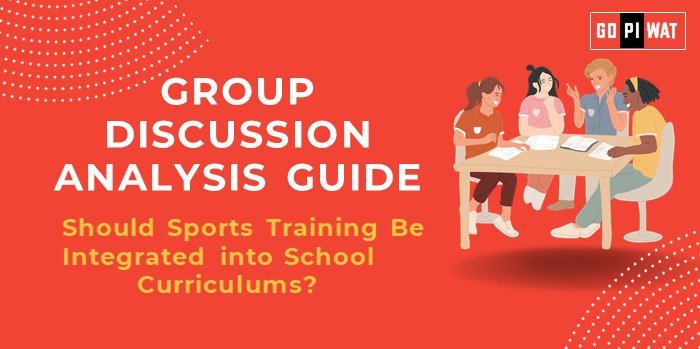📋 Group Discussion Analysis Guide
🏅 Should Sports Training Be Integrated into School Curriculums?
🌟 Introduction to the Topic
- 📜 Opening Context: Sports training in schools is a topic of increasing global relevance as nations focus on nurturing both academic and physical excellence among students. For future B-school students, understanding this issue underscores the importance of holistic education in leadership development.
- 📖 Background: Historically, physical education was considered supplementary to academics. However, recent shifts in educational policies worldwide are integrating sports into core curriculums to foster all-around growth.
📊 Quick Facts and Key Statistics
- ⚠️ Physical Inactivity Crisis: WHO reports that 81% of adolescents worldwide are insufficiently active, emphasizing the need for structured physical education.
- 📈 Academic Benefits: Studies reveal that students participating in sports show up to 40% higher GPAs than non-participants.
- 🌍 Global Implementation: Countries like Finland allocate 1/3rd of school hours to sports, linking it to improved mental health and academic performance.
- 🇮🇳 Indian Context: The National Education Policy (NEP) 2020 recommends integrating physical activities into curriculums to develop critical life skills.
🤝 Stakeholders and Their Roles
- 🏛️ Government: Policy formulation, funding for infrastructure, and national campaigns.
- 🏫 Schools: Implementation of programs, engaging qualified trainers, and ensuring inclusivity.
- 👨👩👧 Parents and Students: Support and active participation.
- ⚽ Sports Bodies and NGOs: Providing expertise, training, and outreach programs.
🎯 Achievements and Challenges
✨ Achievements
- 🧠 Improved cognitive and social skills: Regular sports participation enhances problem-solving and teamwork.
- 🏋️ Health improvements: Reduced obesity rates among students.
- 📉 Success stories: Finland’s curriculum shows a 25% drop in youth depression rates due to mandatory sports.
⚠️ Challenges
- 🏗️ Lack of Infrastructure: Only 50% of Indian schools have adequate sports facilities.
- 📚 Academic Pressure: Resistance from parents prioritizing academics over physical activities.
- 🚺 Gender Disparity: Girls are less likely to participate due to societal norms.
Global Comparisons:
- 🇺🇸 USA: Focus on collegiate athletics as a pathway to professional sports.
- 🇯🇵 Japan: Daily morning exercises in schools boost discipline and focus.
Case Studies:
- 🏅 Kerala’s “Sports for All” program: Increases physical literacy among students.
🗣️ Structured Arguments for Discussion
- 📈 Supporting Stance: “Integrating sports fosters leadership, resilience, and physical well-being, essential for all-rounded student development.”
- ⚖️ Opposing Stance: “Emphasis on sports may dilute academic rigor and create disparities due to unequal access to facilities.”
- 💡 Balanced Perspective: “While sports provide numerous benefits, integration should balance academic and physical goals to maximize student outcomes.”
💬 Effective Discussion Approaches
- 📌 Opening Approaches:
- Start with a global perspective: “Finland dedicates significant school time to sports with proven academic benefits—should India follow suit?”
- Use a statistic: “Over 80% of adolescents are inactive globally—can schools drive change?”
- 🔄 Counter-Argument Handling:
- Point: “Sports may reduce academic time.”
- Rebuttal: “Studies indicate improved cognitive function among student-athletes, compensating for reduced classroom hours.”
📈 Strategic Analysis of Strengths and Weaknesses
Strengths:
- 💪 Enhances health and leadership.
- 📜 Aligns with NEP goals.
Weaknesses:
- 🏗️ Poor rural infrastructure.
- 📚 Resistance from stakeholders.
Opportunities:
- 🎯 Develop national talent pipelines.
- 💼 Attract CSR investments.
Threats:
- ⚠️ Unequal implementation.
- 💸 Budgetary constraints.
🏫 Connecting with B-School Applications
- 📚 Real-World Applications: B-schools can model case studies around sports management and policy implementation.
- 🎓 Sample Interview Questions:
- “How can sports integration improve teamwork in schools?”
- “What are the challenges in balancing academics and sports?”
- 💡 Insights for B-School Students:
- Sports promote leadership qualities.
- Valuable insights for projects in health and education sectors.


